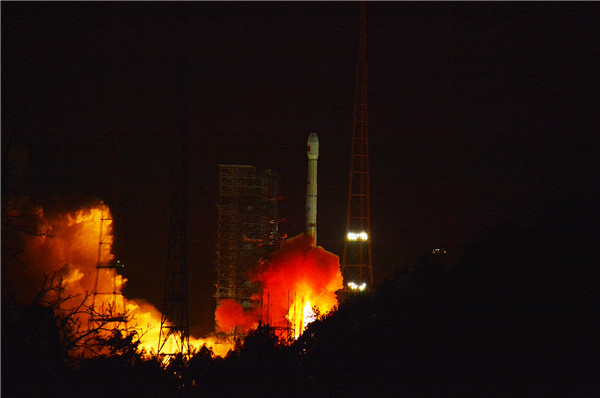

A Long March 3B rocket lifts the satellite from the Xichang Satellite Launch Center in Sichuan province at 12:04 am into the geosynchronous orbit. [Photo by Zhao Zhuqing/People's Daily Online]
China is developing and testing the Tiangong II space laboratory, Shenzhou XI manned spacecraft and Tianzhou I cargo spacecraft amid a massive space exploration drive, according to the country's major spacecraft maker.
"Unlike Tiangong I, the Tiangong II will be a genuine space lab. It is set to perform a lot of space scientific and application experiments and make preparations for our future space station," said Liao Jianlin, deputy chief designer of Tiangong II at the China Academy of Space Technology in Beijing. He made the remark to Chinese reporters in an open house for the media to mark the first China Space Day on Sunday.
The State Council announced in late March that starting this year, April 24 — the day China launched its first satellite into space in 1970 — would be marked as China Space Day.
Liao said Tiangong II has two cabins with different functions. The "experiment cabin" will be hermetically sealed, with astronauts living in it and conducting their missions, while the "resource cabin" will contain solar panels, storage batteries, propellant and engines.
The lab will be launched in the third quarter. The Shen-zhou XI spacecraft, which will carry two astronauts, will be launched in the fourth quarter and will dock with the space lab. The astronauts will stay in Shenzhou XI and Tiangong II for 30 days.
In the first half of next year, a next-generation Long March 7 rocket will transport the Tian-zhou I cargo spacecraft to dock with Tiangong II to resupply fuel and other materials and test in-orbit replenishment technologies, according to the China Manned Space Agency.
The agency said the Shen-zhou XI's two astronauts are receiving training. It added that the Tiangong II, Shen-zhou XI, the two Long March 2F rockets that will send them into space, as well as the Long March 7 rocket and Tianzhou I, are all being assembled.
China's multibillion-dollar manned space program, a source of increasing national pride, aims to put a permanent manned station in space in the near future. The station will consist of a core module attached to two labs, each weighing about 20 metric tons.
Around 2018, China will lift the core module, Tianhe I, into space. The module will have five docking hatches capable of connecting with a cargo spacecraft, two manned spaceships and two experiment cabins. It also will have a hatch for astronauts to exit the space station for activities outside the spacecraft, according to Zhou Jianping, chief designer of the country's manned space program.
By 2022, the Chinese space station will become fully operational, according to the China Manned Space Agency. It noted that China will become the only owner of a space station in 2024, when the International Space Station will retire.
China launched its first space lab, Tiangong I, in September 2011. With a designated life span of two years, it has been in service for four-and-a-half years and is in good condition. The space lab has successfully conducted six automatic and astronaut-controlled dockings with the Shenzhou VIII, Shenzhou IX and Shenzhou X spacecraft.
Currently, there are 106 spacecraft developed by the China Academy of Space Technology that are in active service. The academy is capable of producing 30 spacecraft and developing80 more each year, it said. (China Daily)

86-10-68597521 (day)
86-10-68597289 (night)

86-10-68511095 (day)
86-10-68512458 (night)

cas_en@cas.cn

52 Sanlihe Rd., Xicheng District,
Beijing, China (100864)

